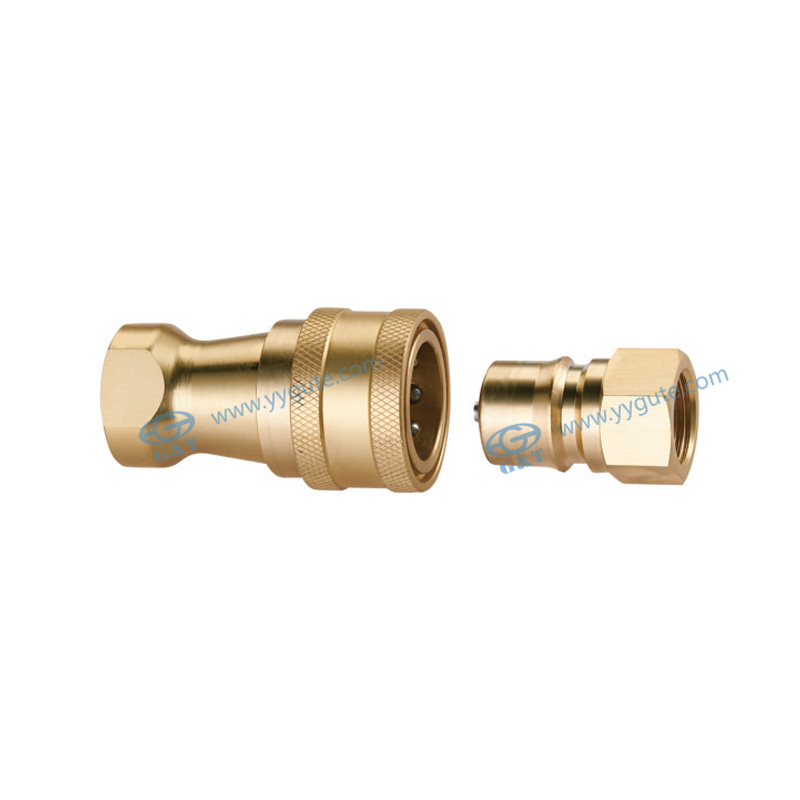What are the typical failure modes of Brass Quick Couplers, and how can they be prevented?
Typical failure modes of Brass Quick Couplers can include:
1.Leakage: Due to wear and tear, improper installation, or damage to seals, Brass Quick Couplers may develop leaks, compromising the integrity of the fluid transfer system.
2.Corrosion: Brass can corrode over time, especially when exposed to harsh environments or incompatible fluids, leading to degradation of the coupler and potential failure.
3.Mechanical Damage: Excessive force during connection or disconnection, impacts, or mishandling can cause mechanical damage to the Brass Quick Coupler, such as deformation or cracking.
4.Wear of Coupling Mechanism: Continuous usage can lead to wear of the coupling mechanism, resulting in decreased effectiveness in sealing and retaining pressure.
5.Chemical Compatibility Issues: Exposure to incompatible fluids or chemicals can degrade the materials of the Brass Quick Coupler, leading to failure over time.
To prevent these failure modes, users can take the following measures:
1.Regular Inspection: Establish a comprehensive inspection protocol for Brass Quick Couplers to proactively identify any potential issues that could compromise their performance or integrity. This protocol should include detailed visual inspections of all components, including the body, seals, and coupling mechanism, to detect signs of wear, corrosion, or damage. Additionally, implement functional tests, such as pressure testing, to verify the sealing effectiveness and overall functionality of the couplers under simulated operating conditions. Consider utilizing advanced inspection techniques, such as non-destructive testing methods like ultrasonic testing or dye penetrant inspection, for more thorough assessment of critical components. Documenting inspection findings in a centralized database or maintenance log allows for tracking trends over time and facilitates data-driven decision-making regarding maintenance and replacement strategies.
2.Maintain Seals: Implement a proactive seal management program to ensure the ongoing effectiveness and reliability of sealing elements in Brass Quick Couplers. This program should include regular inspection and maintenance of seals to detect signs of wear, fatigue, or deterioration and prompt replacement as needed. Select high-quality seals designed for the specific operating conditions and fluid compatibility requirements of your application to optimize sealing performance and longevity. Utilize advanced seal materials and technologies, such as elastomers with enhanced chemical resistance or advanced sealing geometries, to improve reliability and durability in demanding environments. Implement proper storage and handling procedures for spare seals to prevent degradation or contamination prior to installation, and establish a systematic replacement schedule based on operating hours, cycles, or other relevant factors to ensure timely replacement before seal failure occurs.
3.Use Compatible Fluids: Conduct thorough compatibility assessments to determine the suitability of Brass Quick Couplers for handling specific fluids or gases in your application environment. This involves evaluating factors such as chemical composition, temperature, pressure, and flow rates to ensure that the couplers are not exposed to substances that could cause corrosion, erosion, or chemical degradation. Consult material compatibility charts, industry guidelines, and expert recommendations to identify compatible materials for seals and other critical components that may be exposed to potentially aggressive or incompatible fluids. Implement strict fluid management practices, including regular testing and monitoring of fluid quality, filtration, and contamination control measures, to minimize the risk of adverse chemical reactions or contamination that could compromise the integrity and performance of the couplers over time.
KZD medium-pressure high-performance gas-liquid quick coupling












Contact Us